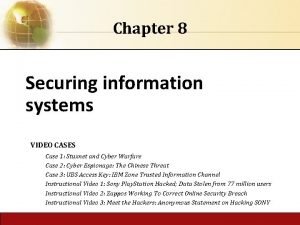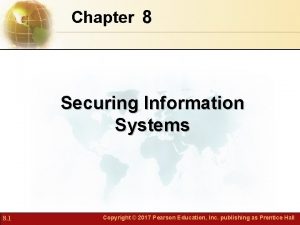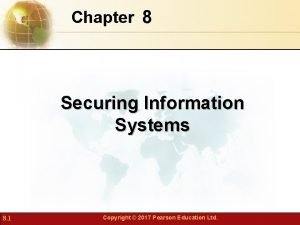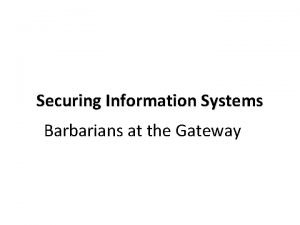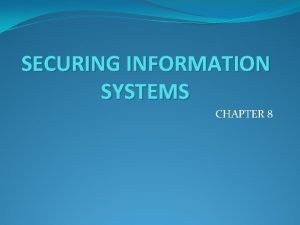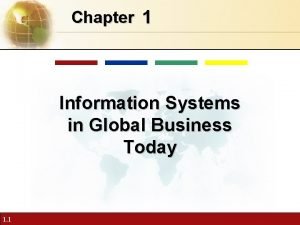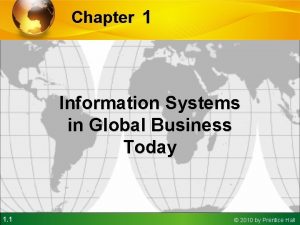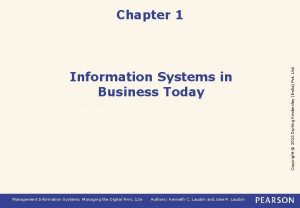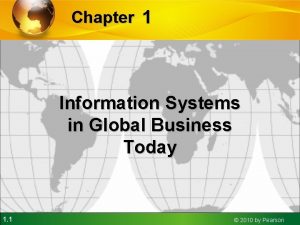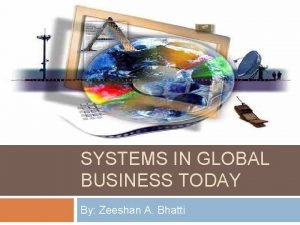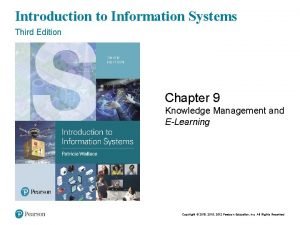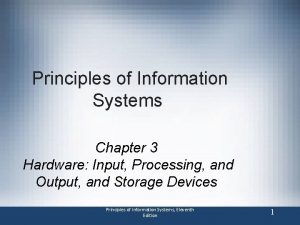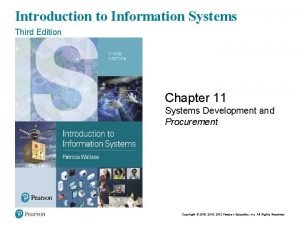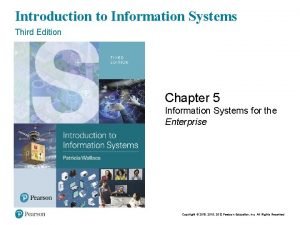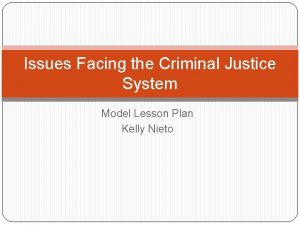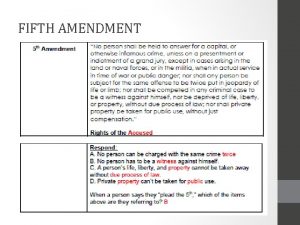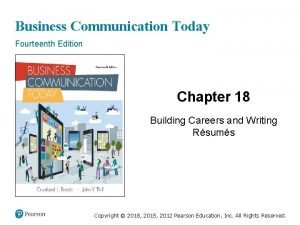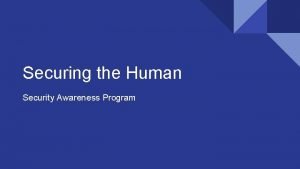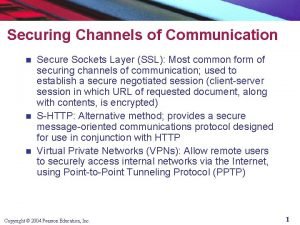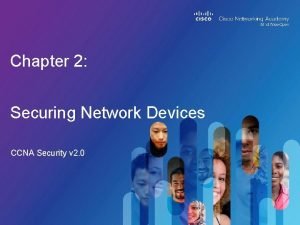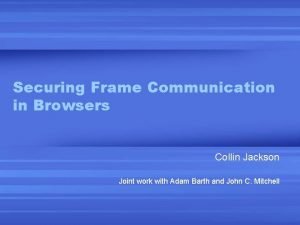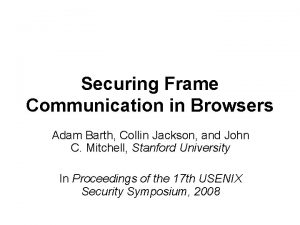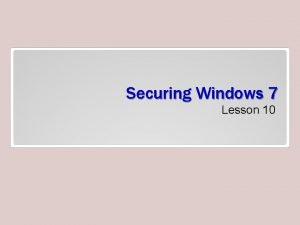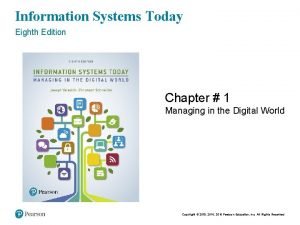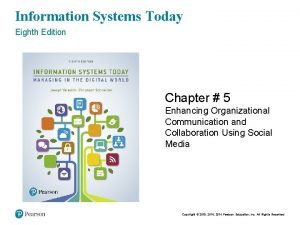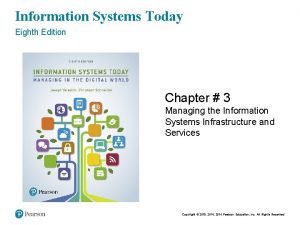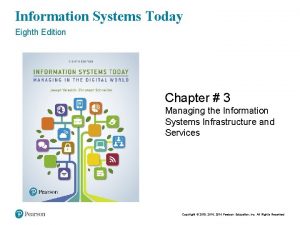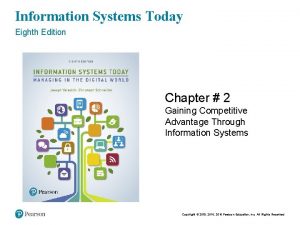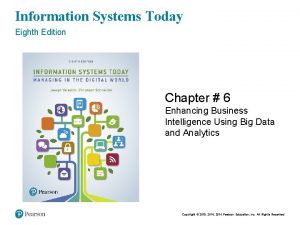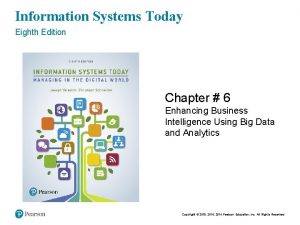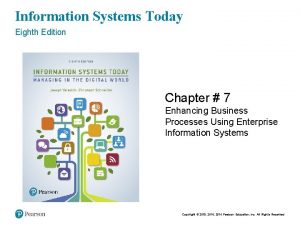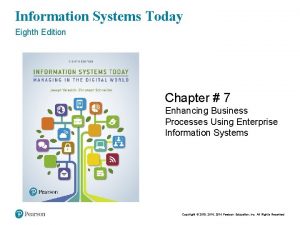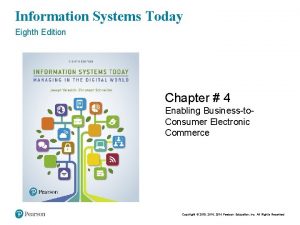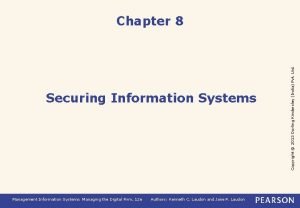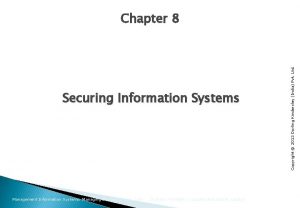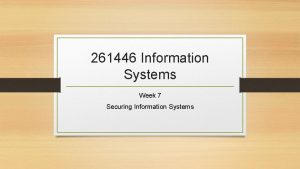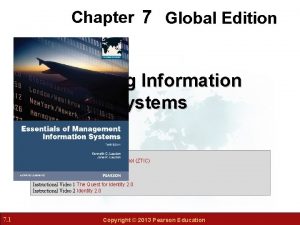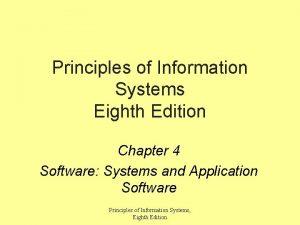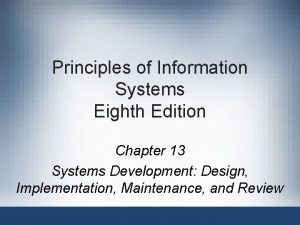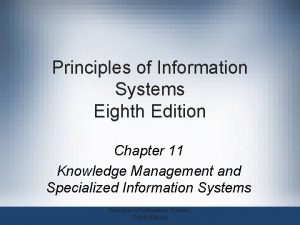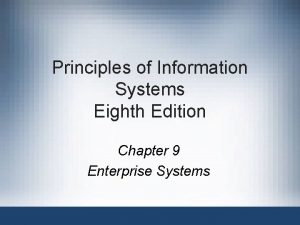Information Systems Today Eighth Edition Chapter 10 Securing

























































- Slides: 57

Information Systems Today Eighth Edition Chapter # 10 Securing Information Systems Copyright © 2018, 2016, 2014 Pearson Education, Inc. All Rights Reserved

Learning Objectives • • • 10. 1 Define computer crime and describe several types of computer crime. 10. 2 Describe and explain differences between cyberwar and cyberterrorism. 10. 3 Discuss the process of managing IS security and describe various IS controls that can help in ensuring IS security. Copyright © 2018, 2016, 2014 Pearson Education, Inc. All Rights Reserved

Computer Crime • Hacking and Cracking • Learning Objective: Define computer crime and describe several types of computer crime. • Types of Computer Criminals and Crimes • Computer Viruses and Other Destructive Code • Cyberharassment, Cyberstalking, and Cyberbullying • Software Piracy • Cybersquatting • Laws Against Computer Crime Copyright © 2018, 2016, 2014 Pearson Education, Inc. All Rights Reserved

What is Computer Crime? • “Using a computer to commit an illegal act” • Targeting a computer while committing an offense – Unauthorized access of a server to destroy data • Using a computer to commit an offense – Using a computer to embezzle funds • Using computers to support criminal activity – Maintaining books for illegal gambling on a computer Copyright © 2018, 2016, 2014 Pearson Education, Inc. All Rights Reserved

Hacking and Cracking • Hackers – Anyone who can gain unauthorized access to computers – White hat hackers don’t intend to do harm • Crackers – Individuals who break into computer systems with the intent to commit crime or do damage – Also called black hat hackers – Hacktivists: Crackers who are motivated by political or ideological goals and who use cracking to promote their interests • Malicious hackers are referred to as black hats and those not motivated to do harm are referred to as white hats Copyright © 2018, 2016, 2014 Pearson Education, Inc. All Rights Reserved

Who Commits Computer Crimes? • Computer criminals come in all shapes and sizes, in order of infractions they are: 1. Current or former employees; most organizations report insider abuses as their most common crime (CSI, 2011) 2. People with technical knowledge who commit business or information sabotage for personal gain 3. Career criminals who use computers to assist in crimes 4. Outside crackers—commit millions of intrusions per year • Studies show that only 10% of cracker attacks cause damage Copyright © 2018, 2016, 2014 Pearson Education, Inc. All Rights Reserved

How Do They Do It? • Technology – Vulnerability scanners – Packet sniffers – Keyloggers – Brute force • Exploiting human weaknesses • Phishing • Social engineering • Shoulder surfing • Dumpster diving Copyright © 2018, 2016, 2014 Pearson Education, Inc. All Rights Reserved

Types of Computer Crimes • Unauthorized Access – Stealing information – Stealing use of computer resources – Accessing systems with the intent to commit information modification • Information Modification – Changing data for financial gain (e. g. , embezzlement) – Defacing a Web site (e. g. , hacktivists making a statement) Copyright © 2018, 2016, 2014 Pearson Education, Inc. All Rights Reserved

Unauthorized Data Modification • Unauthorized data modification can occur in many ways • Some are based on insider threats – Disgruntled employees, contractors • Edward Snowden is a recent example Copyright © 2018, 2016, 2014 Pearson Education, Inc. All Rights Reserved

Other Threats to IS Security Employees keep passwords or access codes on slips of paper in plain sight Individuals have never bothered to install antivirus software, or they install the software but fail to keep it up to date Computer uses within an organization continue to use default network passwords after a network is set up instead of passwords that are more difficult to break Employees are careless about letting outsiders view computer monitors, or they carelessly give out information over the telephone Organizations fail to limit access to company files and system resources Organizations fail to install effective firewalls or intrusion detection systems, or they install an intrusion detection system but fail to monitor it regularly Organizations fail to conduct proper background checks on new hires Fired employees are resentful and install harmful code, such as computer viruses, when they leave the company Copyright © 2018, 2016, 2014 Pearson Education, Inc. All Rights Reserved

Threats From Mobile Devices Mobile Threats Individuals lose their mobile devices and don’t have capabilities to remotely wipe data from the device Individuals keep sensitive data on mobile devices and do not use passcodes Individuals “jailbreak” their mobile phones. Individuals use poorly designed mobile applications that can have security vulnerabilities Individuals use unsecure wireless networks, leaving their devices vulnerable to different types of attacks Copyright © 2018, 2016, 2014 Pearson Education, Inc. All Rights Reserved

Computer Viruses and Other Destructive Code • Computer viruses • Worms, Trojan horses, and other sinister programs • Denial of service • Spyware, spam, cookies • The rise of botnets and the cyberattack supply chain • Identity theft Copyright © 2018, 2016, 2014 Pearson Education, Inc. All Rights Reserved

Computer Viruses Copyright © 2018, 2016, 2014 Pearson Education, Inc. All Rights Reserved

Denial-of-Service Attacks Copyright © 2018, 2016, 2014 Pearson Education, Inc. All Rights Reserved

Spyware, Spam, and Cookies • Spyware – Software that monitors the activity on a computer, such as the Web sites visible or even the key-strokes of the user • Spam – Bulk unsolicited e-mail sent to millions of users at extremely low cost, typically seeking to sell a product, distribute malware, or conduct a phishing attack • Cookies – A small file Web sites place on a user’s computer; can be legitimate (to capture items in a shopping cart) but can be abused (to track individuals’ browsing habits) and can contain sensitive information (like credit card numbers) and pose a security risk Copyright © 2018, 2016, 2014 Pearson Education, Inc. All Rights Reserved

The Rise of Botnets and the Cyberattack Supply Chain • Botnets are software robots working together with zombie computers • 85% Of all e-mail spam is sent by only six botnets • Example phishing attack: – A programmer writes a phishing attack template and sells it – A phisher purchases the template and designs the attack – The phisher contracts with a cracker to host the phishing Web site – The phisher contracts a bot herder to sent the botnets – The collector works with a mule herder to withdraw funds from banks Copyright © 2018, 2016, 2014 Pearson Education, Inc. All Rights Reserved

Identity Theft • Identity theft is one of the fastest growing information crimes • Stealing Social Security, credit card, bank account numbers and information • Possible solutions – Government and private sector working together to change practices – Use of biometrics and encryption Copyright © 2018, 2016, 2014 Pearson Education, Inc. All Rights Reserved

Cyberharassment, Cyberstalking, and Cyberbullying • Cyberharassment – Use of a computer to communicate obscene, vulgar, or threatening content that causes a reasonable person to endure distress • Cyberstalking – Tracking an individual, performing harassing acts not other-wise covered by Cyberharassment, or inciting others to perform harassing acts • Cyberbullying – Deliberately causing emotional distress • All three are closely related, a cyberstalker may be committing Cyberharassment and cyberbullying Copyright © 2018, 2016, 2014 Pearson Education, Inc. All Rights Reserved

Software Piracy (Table 10. 1) Region Piracy Level Dollar Loss (In US$ billions) North America 17% 10. 0 Western Europe 28% 10. 2 Asia/Pacific 61% 19. 1 Latin America 55% 5. 8 Middle East and Africa 57% 3. 7 Central and Eastern Europe 58% 3. 1 Worldwide 39% 52. 2 Source: Based on Business Software Alliance. (2016 Copyright © 2018, 2016, 2014 Pearson Education, Inc. All Rights Reserved

Cybersquatting • Cybersquatting – Buying and holding a domain name with the intent to sell it later for a big profit – The 1999 Anti-Cybersquatting Consumer Protection Act makes it a crime if the intent is to profit from the goodwill of a trademark belonging to someone else Copyright © 2018, 2016, 2014 Pearson Education, Inc. All Rights Reserved

Laws Against Computer Crime • Federal Laws – The Computer Fraud and Abuse Act of 1986 § A crime to access government computers or communications § A crime to extort money by damaging computer systems § A crime to threaten the president, vice president, members of Congress, administration officials – Electronic Communications Privacy Act of 1986 § A crime to break into any electronic communications service, including telephone services § Prohibits the interception of any type of electronic communications Copyright © 2018, 2016, 2014 Pearson Education, Inc. All Rights Reserved

Computer Crime • Learning Objective: Describe and explain differences between cyberwar and cyberterrorism. • Cyberwar • Cyberterrorism Copyright © 2018, 2016, 2014 Pearson Education, Inc. All Rights Reserved

Cyberwar (1 of 2) • Cyberwar Vulnerabilities – Command-and Control systems – Intelligence collection, processing, and distribution systems – Tactical communication systems and methods – Troop and weapon positioning systems – Friend-or-foe identification systems – Smart weapons systems Copyright © 2018, 2016, 2014 Pearson Education, Inc. All Rights Reserved

Cyberwar (2 of 2) • Cyberwar strategy includes controlling Internetbased propaganda – Web vandalism • “Patriot hackers”—governments sometimes blame independent citizens or groups for cyberwar attacks • Stuxnet—malware against an Iranian system – Originally blamed on patriot hackers, then revealed to be developed by the U. S. and Israel Copyright © 2018, 2016, 2014 Pearson Education, Inc. All Rights Reserved

Cyberterrorism (1 of 2) • What kinds of attacks are considered cyberterrorism? – Attacks by individuals and organized groups – Political, religious, or ideological goals • How the Internet is changing the business processes of terrorists – Terrorists are leveraging the Internet to coordinate their activities, recruit, and perform fundraising Copyright © 2018, 2016, 2014 Pearson Education, Inc. All Rights Reserved

Cyberterrorism (2 of 2) • Assessing the cyberterrorism threat – The Internet is generally open and accessible from anywhere in the world – There have been many attacks, and although not significantly damaging, the will and potential exist • The globalization of terrorism – Terrorism is now a global business – Attacks can be launched from anywhere in the world Copyright © 2018, 2016, 2014 Pearson Education, Inc. All Rights Reserved

Cyberterrorist Categories and Internet Use (Tables 10. 3 & 10. 4) Categories of Cyberterrorist Attacks How Terrorist Are Using the Internet Coordinated bomb attacks Information dissemination Manipulation of financial and banking information Data mining Manipulation of the pharmaceutical industry Fundraising Manipulation of transportation control systems Recruiting and mobilization Manipulation of civilian infrastructures Networking & Information sharing Manipulation of nuclear power plants Training Planning and coordinating Information gathering Location monitoring Copyright © 2018, 2016, 2014 Pearson Education, Inc. All Rights Reserved

Managing Information Systems Security • Learning Objective: Discuss the process of managing IS security and describe various IS controls that can help in ensuring IS security. . • Assessing Risks • Developing a Security Strategy • Implementing Controls and Training • Monitoring Security Copyright © 2018, 2016, 2014 Pearson Education, Inc. All Rights Reserved

Threats to IS Security • Securing against these threats must consider these goals: – Availability § Ensuring that legitimate users can access the system – Integrity § Preventing unauthorized manipulations of data and systems – Confidentiality § Protecting data form unauthorized access – Accountability § Ensuring that actions can be traced Copyright © 2018, 2016, 2014 Pearson Education, Inc. All Rights Reserved

Information Systems Security Process • Information systems security is an ongoing process Copyright © 2018, 2016, 2014 Pearson Education, Inc. All Rights Reserved

Assessing IS Risks • Options for addressing risk – Risk Reduction § Actively installing countermeasures – Risk Acceptance § Accepting any losses that occurs – Risk Transference § Have someone else absorb the risk (insurance, outsourcing) – Risk Avoidance § Using alternative means, avoiding risky tasks Interplay between threats, vulnerabilities, and impacts Copyright © 2018, 2016, 2014 Pearson Education, Inc. All Rights Reserved

Developing a Security Strategy • After assessing risk, a strategy is developed detailing the information security controls • Types of controls: – Preventive – Detective – Corrective • Use the principles of least permissions and least privileges Copyright © 2018, 2016, 2014 Pearson Education, Inc. All Rights Reserved

Policies and Procedures • Not all security measures are technical in nature. Managerial activities are important • Policies and procedures include: – – – – Confidential information policy Security policy Use policy Backup policy Account management policy Incident handling procedures Disaster recovery plan Copyright © 2018, 2016, 2014 Pearson Education, Inc. All Rights Reserved

Disaster Planning • Business continuity plan—how a business continues operating after a disaster • Disaster recovery plan—detailed procedures for recovering from systems-related disasters • Questions for a disaster recovery plan: – – – – What events are considered a disaster? What should be done to prepare the backup site? What is the chain of command; who declares a disaster? What hardware and software needed? Which personnel are needed? What is the sequence for moving back to the original location? Which providers can be drawn on to aid in disaster recovery? Copyright © 2018, 2016, 2014 Pearson Education, Inc. All Rights Reserved

Backups • Backup sites are critical for business continuity in the event a disaster strikes • Backup media include CD, external hard drives, and tapes • Cold backup site—an empty warehouse with all necessary connections for power and communication but nothing else • Hot backup site—fully equipped backup facility, all needed equipment and one-to-one replication of current data Copyright © 2018, 2016, 2014 Pearson Education, Inc. All Rights Reserved

Designing the Recovery Plan • Recovery time objectives – Specify the maximum time allowed to recover from a catastrophic event – Minutes, hours, days? • Recovery point objectives – Specify how current the backup data should be – Mission-critical transactions data need to be very current – Hot backup involves mirrored data Copyright © 2018, 2016, 2014 Pearson Education, Inc. All Rights Reserved

Implementing Controls and Training • Commonly used controls: – Physical access restrictions – Firewalls – Encryption – Virus monitoring and prevention – Secure data centers – Systems development controls – Human controls Copyright © 2018, 2016, 2014 Pearson Education, Inc. All Rights Reserved

Physical Access Restrictions • Physical access controls typically focus on authentication – Something you have § Keys § Smart cards – Something you know § Password § PIN code – Something you are § Biometrics A smart card Source: al 62/Fotolia Copyright © 2018, 2016, 2014 Pearson Education, Inc. All Rights Reserved

Types of Physical Access Restrictions • Methods for implementing physical access control – Biometrics § Identification via fingerprints, retinal patterns in the eye, facial features, or other bodily characteristics – Two-Factor Authentication § The use of two types of credentials to gain access to a system – Access-Control Software § Allowing computer users access only to those files related to their work § Restricting type of access (read, write, delete, etc. ) – Wireless LAN (WLAN) Controls § Securing wireless networks prevents drive-by-hacking – Virtual Private Networks(VPN) § Also called a secure tunnel Copyright © 2018, 2016, 2014 Pearson Education, Inc. All Rights Reserved

Firewalls • Firewalls filter traffic – Incoming and/or outgoing traffic – Filter based on traffic type – Filter based on traffic source – Filter based on traffic destination – Filter based on combinations of parameters Copyright © 2018, 2016, 2014 Pearson Education, Inc. All Rights Reserved

Encryption and VPN Copyright © 2018, 2016, 2014 Pearson Education, Inc. All Rights Reserved

Firewalls • A Firewall is part of a computer system designed to detect intrusion and prevent unauthorized access to or from a private network • Think of it as a “security fence” Copyright © 2018, 2016, 2014 Pearson Education, Inc. All Rights Reserved

Virus Monitoring and Prevention • Standard precautions – Install antivirus software – Do not use flash drives or shareware from unknown or suspect sources – Delete without opening any e-mail from unknown sources – Do not blindly open any e-mail attachments – If your computer system contracts a virus, report it Copyright © 2018, 2016, 2014 Pearson Education, Inc. All Rights Reserved

Secure Data Centers • Securing the facility’s infrastructure – Site selection – Physical access restrictions – Intrusion detection – Uninterruptible power supply – Protection from environmental threats Copyright © 2018, 2016, 2014 Pearson Education, Inc. All Rights Reserved

Other Controls • Mobile device management • Systems development controls • Human controls • Deployment and training Copyright © 2018, 2016, 2014 Pearson Education, Inc. All Rights Reserved

Monitoring Security • Monitoring external events – Information Sharing and Analysis Centers, United States Computer Emergency Readiness Team • IS Auditing – External entity reviews the controls to uncover any potential problems • Sarbanes-Oxley Act – Best practices: Control Objectives for Information and related Technology (COBIT) • Responding to Security Incidents • Computer Forensics – Examining the computers of crime victims for evidence – Auditing computer activity logs Copyright © 2018, 2016, 2014 Pearson Education, Inc. All Rights Reserved

The Sarbanes-Oxley Act • The Sarbanes-Oxley (S-OX) Act addresses financial controls – Companies must demonstrate that controls are in place – Companies must preserve evidence documenting compliance – Information systems typically used to meet compliance requirements – Growing need for IS auditors Copyright © 2018, 2016, 2014 Pearson Education, Inc. All Rights Reserved

END OF CHAPTER CONTENT Copyright © 2018, 2016, 2014 Pearson Education, Inc. All Rights Reserved

Managing in the Digital World: Not So “Anonymous”— Activists, Hacktivists, or Just Plain Criminals? • Anonymous – A loose collection of hacktivists – Practice civil disobedience by taking part in cyberattacks on Web sites (e. g. , Wiki. Leaks) – Politically active: launching attacks on Israeli government for Gaza Strip military actions – Well known for Internet vigilantism – Claiming to have good intentions, but activities are illegal – Dilemma between pursuing ideological goals and crossing the bounds of legality Copyright © 2018, 2016, 2014 Pearson Education, Inc. All Rights Reserved

Green IT: Anonymous Protests the Killing of Dolphins and Whales in Japan • Anonymous is a hacking group that plots its own course in “green computing” • Every year from Sept-March thousands of dolphins are slaughtered for consumption • 2016, Anonymous targeted hundreds of Japanese websites in defense of whales and dolphins • They targeted Nissan with a denial-of-service attack and stated that they had no intention of stealing any information just support of green computing Copyright © 2018, 2016, 2014 Pearson Education, Inc. All Rights Reserved

When Things Go Wrong: The Bug That Almost Killed the Internet • Open. SSL is a popular encryption framework used to secure many Internet-based transactions • Its heartbleed bug is a flow that was created in 2011 and wasn’t fixed until 2014 • Attackers can compromise encryption keys, user names, passwords, and sensitive data • The vulnerability potentially affects thousands of companies and millions of users Copyright © 2018, 2016, 2014 Pearson Education, Inc. All Rights Reserved

Who’s Going Mobile: Backdoors in Any Mobile Phone? • In 2015, the San Bernardino terrorist attack killed 14 and injured 22. • FBI requested Apple to give them a backdoor so they could access the phone used in the attack • Apple refused (customer security), and the FBI sued Apple • FBI found a way to get the phone unlocked • Security advocates state that “security of general population” is more important than personal security • Debate will rage on over privacy for many years Copyright © 2018, 2016, 2014 Pearson Education, Inc. All Rights Reserved

Ethical Dilemma: Ethics and Cyberwar: Just Because We Can, Should We? • Exponential increase in technology has outpaced the laws to govern the same • Drones can be flown by personnel in a safe place to drop bombs without being harmed • Cyberwar raises many serious issues for society • Collateral damage to civilian targets is a concern • Repairing damage by cyberattacks may be difficult • What about a country’s power grid, banking? Copyright © 2018, 2016, 2014 Pearson Education, Inc. All Rights Reserved

Security Matters: Back to the Future: Analog May Be the Future of Securing Critical Infrastructure • The world has moved from analog to digital • Digital easier to be hacked and attacked, and then shared online with others • Cyberterrorism expert advocates to go back to analog for security purposes • Any digital system connected to a network can be hacked from anywhere worldwide • An old-school analog system requires a human operator to turn a dial or flip a switch (analog equipment cannot be infected by malware) Copyright © 2018, 2016, 2014 Pearson Education, Inc. All Rights Reserved

Coming Attractions: Can You Become Your Password? • Passwords are easy to forget, fingerprints are not • Once criminals gain access to your biometric you are compromised forever (can’t change it) • Researchers have suggested Brain Scans (reading a sentence) because each person’s brain acts differently • Brainwaves would be used by the security system, and they do not leave any tracks and cannot be manipulated by cyber criminals Copyright © 2018, 2016, 2014 Pearson Education, Inc. All Rights Reserved

Industry Analysis: Cybercops Track Cybercriminals • Police departments have been playing catch-up with technology, but are now making great strides – Computer Crime and Intellectual Property Section of DOD is dedicated to tracking cybercrime – FBI has dedicated cybercrime resources in 56 field offices – Every state has a computer crime investigation unit – Software tools for law enforcement have improved significantly Examples: § Software Forensic Tool Kit § Statewide Network of Agency Photos (SNAP) database • While criminals may now be using technology to commit crimes, law enforcement is using technology to catch them Copyright © 2018, 2016, 2014 Pearson Education, Inc. All Rights Reserved

Copyright © 2018, 2016, 2014 Pearson Education, Inc. All Rights Reserved
 Chapter 8 securing information systems
Chapter 8 securing information systems Chapter 8 securing information systems
Chapter 8 securing information systems Chapter 8 securing information systems
Chapter 8 securing information systems Chapter 8 securing information systems
Chapter 8 securing information systems Chapter 8 securing information systems
Chapter 8 securing information systems Securing information systems
Securing information systems Securing information systems
Securing information systems Psychology eighth edition david g myers
Psychology eighth edition david g myers Reuptake psychology
Reuptake psychology Operations management eighth edition
Operations management eighth edition Information systems in global business today
Information systems in global business today Information system in global business
Information system in global business Objective of a business firm?
Objective of a business firm? Information system in global business today
Information system in global business today Information systems in global business today
Information systems in global business today Information system in global business today
Information system in global business today Introduction to information systems 6th edition
Introduction to information systems 6th edition Fundamentals of information systems 9th edition
Fundamentals of information systems 9th edition Fundamentals of information systems 9th edition
Fundamentals of information systems 9th edition Introduction to information systems 6th edition
Introduction to information systems 6th edition Management information systems 16th edition
Management information systems 16th edition Introduction to information systems 3rd edition
Introduction to information systems 3rd edition Introduction to information systems 5th edition
Introduction to information systems 5th edition Principles of management information system
Principles of management information system Principles of information systems 11th edition
Principles of information systems 11th edition Fundamentals of information systems 9th edition
Fundamentals of information systems 9th edition Essentials of mis, 13th edition
Essentials of mis, 13th edition Introduction to information systems 3rd edition
Introduction to information systems 3rd edition Fundamentals of information systems 9th edition
Fundamentals of information systems 9th edition Introduction to information systems 3rd edition
Introduction to information systems 3rd edition Chapter 8 securing the republic summary
Chapter 8 securing the republic summary Anagram of eighth
Anagram of eighth Matching planet rings
Matching planet rings Nearest eighth of an inch
Nearest eighth of an inch The fifth, sixth, seventh, and eighth amendments protect *
The fifth, sixth, seventh, and eighth amendments protect * What is the eighth commandment catholic
What is the eighth commandment catholic What is the eighth wonder
What is the eighth wonder Reverse partial veneer crown
Reverse partial veneer crown Eighth amendment excessive bail
Eighth amendment excessive bail Eighth letter of the alphabet
Eighth letter of the alphabet Criminal justice lesson
Criminal justice lesson Eighth amendment excessive bail
Eighth amendment excessive bail For today's meeting
For today's meeting Are you going to class today
Are you going to class today Today meeting or today's meeting
Today meeting or today's meeting Fingerprint galton details
Fingerprint galton details Today's lesson or today lesson
Today's lesson or today lesson Example of repitition
Example of repitition Business communication today chapter 1
Business communication today chapter 1 Criminology today 7th edition
Criminology today 7th edition Mis chapter 6
Mis chapter 6 Using mis 10th edition
Using mis 10th edition Securingthehuman sans org
Securingthehuman sans org The most common form of securing channel through
The most common form of securing channel through Securing network devices
Securing network devices Securing frame communication in browsers
Securing frame communication in browsers Adam secure browser
Adam secure browser Securing windows 7
Securing windows 7


